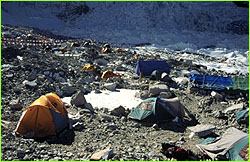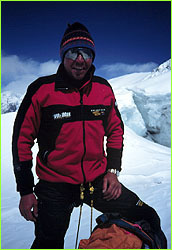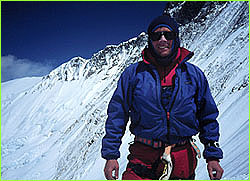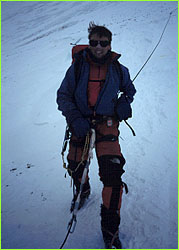
|
 |
 |
Thin Air Page 3 | Back to Page 1 A Gamow Bag is a portable fabric hyperbaric chamber that can be inflated with a rafting-style foot pump to a pressure of about two psi (pounds per square inch). The pressured differential, or change in altitude, that can be simulated depends on the altitude at which the bag is used. At Everest Base Camp, for example, a patient can be "descended" (this is a pressure descent) 8,000 feet  at about two psi. That would put the patient at a relatively
comfortable altitude of 9,600 feet. In Kathmandu valley, which
is approximately 6,000 feet, a patient can be descended 5000
feet (close to sea level).
at about two psi. That would put the patient at a relatively
comfortable altitude of 9,600 feet. In Kathmandu valley, which
is approximately 6,000 feet, a patient can be descended 5000
feet (close to sea level). While the bag is being pumped up, the patient inside often develops mild ear pressure and feels an increase in temperature due to the compression of air molecules within the enclosed space. A small window is available for the doctor to monitor the patient visually, and although communication is slightly muffled, patients can be heard. Doctors often tape a hand-held altimeter to the corner of the window so the patient's initial "descent," and then their return "ascent," can be precisely monitored. For mild forms of altitude sickness, an hour inside the bag is typically sufficient, whereas for severe forms of mountain sickness, four to six hours or more may be necessary. The unfortunate reality of Gamow Bags is that ultimately patients have to get out of them, and they're back at the same altitude where they began. Mal Duff  The death of Mal Duff left a heavy silence around Base Camp
for two days. The wind blew ceaselessly for those 48 hours, as
we all tried to come to terms with the shock of losing one of
Everest's longtime expedition leaders. Mal had a personality
that affected everyone differently, "Mal was a quiet but firm
leader with a wonderful sense of humor and tremendous
patience. As a leader, he was admired and respected by
Westerners and Sherpas alike. It was always a pleasure to come
across Mal somewhere on the route on Everest," reflects David.
The death of Mal Duff left a heavy silence around Base Camp
for two days. The wind blew ceaselessly for those 48 hours, as
we all tried to come to terms with the shock of losing one of
Everest's longtime expedition leaders. Mal had a personality
that affected everyone differently, "Mal was a quiet but firm
leader with a wonderful sense of humor and tremendous
patience. As a leader, he was admired and respected by
Westerners and Sherpas alike. It was always a pleasure to come
across Mal somewhere on the route on Everest," reflects David.
Catching Up with Ed Viesturs and David Carter All had been going well for both Ed Viesturs and David Carter on the mountain. Because they are climbing for the New Zealand expedition, they are on a  different acclimatization schedule. However, David, Pete, and
Jangbu have passed them on the route on a few occasions. They
were able to meet up at Camp III to do some filming and
conduct psychometric tests.
different acclimatization schedule. However, David, Pete, and
Jangbu have passed them on the route on a few occasions. They
were able to meet up at Camp III to do some filming and
conduct psychometric tests. Ed, who, unlike last year, is climbing with oxygen this year, was able to spend some time with us at Base Camp. "For me, climbing without oxygen is much more enjoyable than climbing with oxygen," commented Ed. "Even though physically it's harder, I feel less encumbered by the apparatus and oxygen mask on my face, which tends to be a little claustrophobic. I breathe huge volumes of air up there and I often have to take the mask off to get enough air. And so it's a little bit of a weird sensation; even though it should be easier with oxygen, for me it seems like it's easier without. Whether that's psychological or not, I don't know. But when I'm guiding I use oxygen simply because it's safer. If anything were to go wrong, I have oxygen, and I'm maybe a little quicker mentally." Ed will be breathing supplemental oxygen from Camp IV and beyond. Tashi Tenzing, Tenzing Norgay's grandson, is among Ed's clients this year. Interestingly enough, Tashi is the only "client" that Ed and Carter will be climbing with this year; the other clients on the expedition dropped out during the acclimatization process. Ed explains how this process works: "First of all, we look at their physical fitness and how they perform day to day and camp to camp, how they react to the altitude, what they look like and how they feel when they get to a certain camp. Do they still have enough energy to perform basic tasks? Do they have enough energy to get down? Getting up is half of the climb. Getting down is the second and most important half of the climb. You always have to be evaluating and looking at their performance."  David Carter was able to give us a status report on how he's
doing this year as compared to his attempt on Everest in 1991:
"I feel much better this year. I have not lost any weight so
far. It's been amazing. My acclimatization has been easy. I
have not had any headaches thus far. The only problem I have
had is a high altitude cough. I'm starting to lose my voice.
My main concern right now is as I get higher the cough will
get worse and I'm worried about breaking a rib or vomiting or
something. I've been keeping a scarf over my mouth when I
climb past Camp II."
David Carter was able to give us a status report on how he's
doing this year as compared to his attempt on Everest in 1991:
"I feel much better this year. I have not lost any weight so
far. It's been amazing. My acclimatization has been easy. I
have not had any headaches thus far. The only problem I have
had is a high altitude cough. I'm starting to lose my voice.
My main concern right now is as I get higher the cough will
get worse and I'm worried about breaking a rib or vomiting or
something. I've been keeping a scarf over my mouth when I
climb past Camp II.""Can you describe for us what the high altitude cough is?" "It's a real violent cough. It comes from deep within and you can't control it. Usually it starts when you stop climbing for some reason. You are at a rest  break or you are in your sleeping bag at night and it is so
violent that sometimes you get nauseous. The problem is that
when you get nauseous you try to hold that cough in and that
is when you can break a rib and that's what I did in 1991."
break or you are in your sleeping bag at night and it is so
violent that sometimes you get nauseous. The problem is that
when you get nauseous you try to hold that cough in and that
is when you can break a rib and that's what I did in 1991.""Can you tell us why you've come back this year to climb Everest?" "I feel like I have some unfinished business. In 1991, I don't think I climbed the mountain right. 1991 was more of a learning year for me to climb this mountain. This year I feel like I'm pacing myself better, I'm taking better care of myself. I know the route and that makes a really big difference this year. Plus, I feel like I'm acclimating better because I've been here before. I've been to 26,000 feet and I think my body knows that. I'm not as scared as I was in 1991. The stress makes a big difference in acclimatization also." All of our climbers have climbed to Camp III and slept there—the 24,000-foot camp on Everest that will be their last acclimatization stop before heading into the so-called "Death Zone" above 26,000 feet. Not one has felt inhibited by the thin air of the extreme altitudes they have been climbing in. They wait with us here at Base Camp for good weather to open up a window of opportunity for their journey to the top of the world. Follow the climbers from Base Camp to the summit, or log on to our newsflashes for more regular updates from the field. Photos: (1-3) Pete Athans; (4-7, 10, 11) David Breashears; (8, 9) Aaron Strong; (12, 14) Ed Viesturs; (13) David Carter. Lost on Everest | High Exposure | Climb | History & Culture | Earth, Wind, & Ice E-mail | Previous Expeditions | Resources | Site Map | Everest Home Editor's Picks | Previous Sites | Join Us/E-mail | TV/Web Schedule About NOVA | Teachers | Site Map | Shop | Jobs | Search | To print PBS Online | NOVA Online | WGBH © | Updated November 2000 |